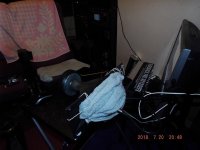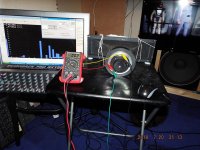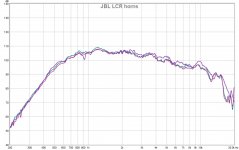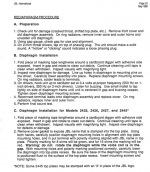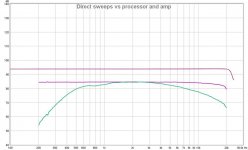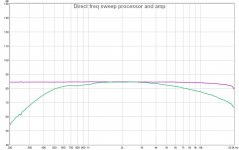I know there must be hundreds of threads like this one but this is mine of the JBL 2416 diaphragm or could be, yours or his or her's.
Adjusting the HF compression driver diaphragm on the phase -plug while checking with sine wave tones and looking for harmonic distortions frequencies that will exist above the pure tone of the generated sine wave tone for example.
If I use 500Hz sine wave and purposely miss-align one of the x3 screws that tighten down the diaphragm the 500Hz could drop by several db and produce other tone frequencies above it that just sound horroble like distortion or harmonic distortion. Its a slow and tedious process that simple can not be rushed.
Screen capture shows purposely miss-align all three screws and it started to resonate distort generating other frequencies or harmonic distortion RED CIRCLE. Its kind of like tightening up a water pipe so that it doesn't leak water the valve needs to be secure to hold the pressure inside and its same with compression driver the sound is being produced by diaphragm and the magnetic field of the magnet and the jiggling of the diaphragm by hand while observing the frequency on the RTA and carefully tightening down each of the three screws (slowly) while listening and still observing the RTA.
Another note I forgot to mention is that the volume level also needs to be raised to see if sound pressure increases or seems like its been compressed down also it may produce a harmonic distortion again once reaching a certain SPL db or voltage. Its headache of an alignment.
Another screen capture shows a mild thou not sure if I can call it mild harmonic at 1Khz I can bare even hear it as the 500Hz sine wave being generated is masking the harmonic but that doesn't mean its not there as I can see it.
Another screen capture showing 1Khz sine wave being generated and the harmonic distortion is few cycles above CIRCLED IN RED. Again very hard to hear the harmonic.
I have x5 JBL horns to do for my JBL five-screen channels.
Adjusting the HF compression driver diaphragm on the phase -plug while checking with sine wave tones and looking for harmonic distortions frequencies that will exist above the pure tone of the generated sine wave tone for example.
If I use 500Hz sine wave and purposely miss-align one of the x3 screws that tighten down the diaphragm the 500Hz could drop by several db and produce other tone frequencies above it that just sound horroble like distortion or harmonic distortion. Its a slow and tedious process that simple can not be rushed.
Screen capture shows purposely miss-align all three screws and it started to resonate distort generating other frequencies or harmonic distortion RED CIRCLE. Its kind of like tightening up a water pipe so that it doesn't leak water the valve needs to be secure to hold the pressure inside and its same with compression driver the sound is being produced by diaphragm and the magnetic field of the magnet and the jiggling of the diaphragm by hand while observing the frequency on the RTA and carefully tightening down each of the three screws (slowly) while listening and still observing the RTA.
Another note I forgot to mention is that the volume level also needs to be raised to see if sound pressure increases or seems like its been compressed down also it may produce a harmonic distortion again once reaching a certain SPL db or voltage. Its headache of an alignment.
Another screen capture shows a mild thou not sure if I can call it mild harmonic at 1Khz I can bare even hear it as the 500Hz sine wave being generated is masking the harmonic but that doesn't mean its not there as I can see it.
Another screen capture showing 1Khz sine wave being generated and the harmonic distortion is few cycles above CIRCLED IN RED. Again very hard to hear the harmonic.
I have x5 JBL horns to do for my JBL five-screen channels.
Attachments
-
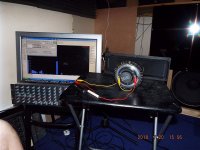 37399819_10156371948765149_3448061755966619648_n.jpg91.4 KB · Views: 197
37399819_10156371948765149_3448061755966619648_n.jpg91.4 KB · Views: 197 -
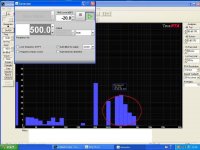 37568737_10156371981030149_4807555515175403520_n.jpg94.4 KB · Views: 202
37568737_10156371981030149_4807555515175403520_n.jpg94.4 KB · Views: 202 -
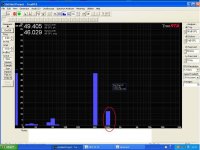 37403500_10156372005430149_4155769708039110656_n.jpg102.7 KB · Views: 185
37403500_10156372005430149_4155769708039110656_n.jpg102.7 KB · Views: 185 -
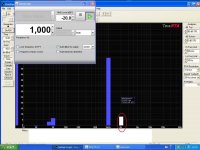 37392881_10156372018010149_1976659329620639744_n.jpg94 KB · Views: 178
37392881_10156372018010149_1976659329620639744_n.jpg94 KB · Views: 178 -
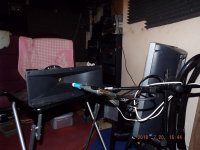 37652687_10156372047250149_5003220326666993664_n.jpg69.7 KB · Views: 187
37652687_10156372047250149_5003220326666993664_n.jpg69.7 KB · Views: 187
Last edited:
The gross misalignment with the third harmonic about -10 dB from the fundamental is around 32% THD (total harmonic distortion), quite obvious. -33 harmonics puts THD <3%, difficult to detect by ear, and -52 dB <.32%, less THD than most could detect.Another screen capture shows a mild thou not sure if I can call it mild harmonic at 1Khz I can bare even hear it as the 500Hz sine wave being generated is masking the harmonic but that doesn't mean its not there as I can see it.
Another screen capture showing 1Khz sine wave being generated and the harmonic distortion is few cycles above CIRCLED IN RED. Again very hard to hear the harmonic.
The alignment process is much easier if the horn is stuffed with rags and lower frequencies (200-400 Hz) are used, then even small mis-alignments will be obvious by ear, as the harmonics will sound louder than the fundamental tone. Also, using 3 to 6 volts won't deafen you in the process ;^).
Last edited:
weltersys, out of 81 so views cheers for chiming in here is ice cube chilled lemonade. 
I get the idea with stuffing the horn throat up and with microphone inside I know its going to alter the pink noise. I'll try that stuff the horn up with another same JBL horn once I have established a characteristic signature that sounds smooth and looks smooth with little dips or peaks as some part of the design on the horn and its phase-plug and diaphragm need careful gentle movement and tension of the screws adjustment in odd sequences as slightly bit too much pressure of the screw the pink-noise frequency suddenly jumps with brittle top end.
Sometimes you can hear high frequency venting leaking from the side of diaphragm and again needs careful alignment.
I have managed to run films on the horns in small room at close distance down 300Hz with Star Trek II the wrath of Khan.
Any idea please as to the 6volts as that would be a little or over or under 10watts? Or am I mistaken?
I do have multi-meter. But never tested volts with speakers on it yet only checking for impedance/ohms. Would I use a steady sine wave to check for voltage as pink noise is going to be randomly fluctuation up and down.

I get the idea with stuffing the horn throat up and with microphone inside I know its going to alter the pink noise. I'll try that stuff the horn up with another same JBL horn once I have established a characteristic signature that sounds smooth and looks smooth with little dips or peaks as some part of the design on the horn and its phase-plug and diaphragm need careful gentle movement and tension of the screws adjustment in odd sequences as slightly bit too much pressure of the screw the pink-noise frequency suddenly jumps with brittle top end.
Sometimes you can hear high frequency venting leaking from the side of diaphragm and again needs careful alignment.
I have managed to run films on the horns in small room at close distance down 300Hz with Star Trek II the wrath of Khan.
Any idea please as to the 6volts as that would be a little or over or under 10watts? Or am I mistaken?
I do have multi-meter. But never tested volts with speakers on it yet only checking for impedance/ohms. Would I use a steady sine wave to check for voltage as pink noise is going to be randomly fluctuation up and down.
Stuff one my best towels in the JBL horn. I'm gonna need my towel back as I'm sweating in this muddle sticky heat at the moment. Its okay I have another towel. 
Attached multi-meter up.
I had to readjust the gain level on the preamp due to microphone being in close proximity even thou its about another 2 inches and bit down and past the phase-plug to the diaphragm.
A bit louder picking up resonate harmonic at 500Hz as fader level is bit higher than when I had the microphone in front of the horn. I tried 200Hz but the range rolls off drops off a lot and I can barely hear the tone but dear push the amplifier gain level higher as I not lost a horn this way as of yet and I don't like waiting week for new diaphragm to arrive it vexes me. I like listening to films on horns.
I wonder what the JBL factor procedure is when they set up the diaphragms to the phase-plugs for their horns? I not seen a single one video yet lots of videos of how Saturn V was all tested and put together so come on I want see an JBL horn set up video.
Attached multi-meter up.
I had to readjust the gain level on the preamp due to microphone being in close proximity even thou its about another 2 inches and bit down and past the phase-plug to the diaphragm.
A bit louder picking up resonate harmonic at 500Hz as fader level is bit higher than when I had the microphone in front of the horn. I tried 200Hz but the range rolls off drops off a lot and I can barely hear the tone but dear push the amplifier gain level higher as I not lost a horn this way as of yet and I don't like waiting week for new diaphragm to arrive it vexes me. I like listening to films on horns.
I wonder what the JBL factor procedure is when they set up the diaphragms to the phase-plugs for their horns? I not seen a single one video yet lots of videos of how Saturn V was all tested and put together so come on I want see an JBL horn set up video.
Attachments
Last edited:
I been at this for 8 hours that's how tedious it can be.
I take another go at the horns another day best I can get so far (again) a few little tiny fraction snags that need a little more adjustment to one horns. The diaphragms are not all the same as some are originals others are after market versions and some of them fitting into the phase-plug I believe creates a wee bit of tiny deviation of misalignment but I think I can tolerate it for a day or two.
I have to use the EQ PEQ with a little Quality expanding the frequency bandwidth to correct.
Ideally I want total transparency of frequency and phase as I like listening to movies with accurate timber balance with directional dialouge/sound effects and music.
I take another go at the horns another day best I can get so far (again) a few little tiny fraction snags that need a little more adjustment to one horns. The diaphragms are not all the same as some are originals others are after market versions and some of them fitting into the phase-plug I believe creates a wee bit of tiny deviation of misalignment but I think I can tolerate it for a day or two.
I have to use the EQ PEQ with a little Quality expanding the frequency bandwidth to correct.
Ideally I want total transparency of frequency and phase as I like listening to movies with accurate timber balance with directional dialouge/sound effects and music.
Attachments
Last edited:
Pink noise does not allow one to notice the harmonics created by dragging voice coils/formers, and as you mention, difficult to determine a specific voltage with 12 dB of fluctuation.Any idea please as to the 6volts as that would be a little or over or under 10watts? Or am I mistaken?
I do have multi-meter. But never tested volts with speakers on it yet only checking for impedance/ohms. Would I use a steady sine wave to check for voltage as pink noise is going to be randomly fluctuation up and down.
I tried 200Hz but the range rolls off drops off a lot and I can barely hear the tone but dear push the amplifier gain level higher as I not lost a horn this way as of yet and I don't like waiting week for new diaphragm to arrive it vexes me.
Using sine waves at lower frequencies, since the driver output is so low, the harmonics created by dragging are more obvious. One still needs to sweep through the entire range to detect all problems.
2.83 volts is one watt into an 8 ohm load, 4 volts is one watt into 16 ohms, I did not check the impedance of your drivers.
6 volts would be 4.5 watts into a nominal 8 ohm load, still safe from a thermal standpoint for drivers like yours, but 3 volts is plenty for an 8 ohm diaphragm.
With frequencies as low as 200 Hz on 1.75" diaphragms, even a properly aligned diaphragm will sound distorted, which is probably why the May 1988 JBL Rediaphragm procedure mentions 550 Hz for "one inch" and 350 Hz for "two inch" drivers.
I learned how to align diaphragms over a decade before that...
At any rate, at least you understand that JBL diaphragms still need alignment!
Art
Attachments
weltersys
With all the crappy letters I get in the post that JBL read was by far the best reading I've had so far this year.
I have another go maybe later today if my arms aren't still aching my fingers feel like they been handling JBL horns for 8 hours.
I cleaned the voice coil gap before finally fitting all x3 down and have the other x2 to check not now I'm shattered.
On the multi-meter I have in the picture if you click on large picture you can see 00.0 so I gather the 6v would be 00.6 as it gets loud as it is at 00.1 and I went up 00.2 but after that I will use earplugs and get my two cats out of the room as that is going to be like what SPL db? Way too loud! I never run the horns max level they are good but I don't need max level otherwise its gonna be too sensitive or ear-bleeding and then LF lows will need insanely raised gain levels. 85db or a little less is action fine in the small room for movies.
Should I have an extra 0 on the multi-meter I mean I can't see the very small mill-volts.
I'd like to have the larger JBL horns but room is too small for a five-screen horns the JBL 2370A is only fraction larger and still a 1" CD. I'm chuffed with my JBL 2371 I'm sure George Lucas would rate them if they can handle highs loudly.
As for the pink noise I use that to give me rough idea to when wiggling diaphragm so I don't huge dip/peaks then do the frequency sweep and see what little frequencies I can pick at.
I think I got the horns sounding as about better than the last time as I didn't spend nowhere near to 8 hours maybe 2 or 3 hours.
Also when sticking the mic inside the throat is like being near to a mini boundaries well I can place myself inside that throat (not in the way your thinking) It gives me different readings on frequency sweep graph. Then move mic out into the room within the room itself then gives its own readings and outside testing would be a lot different. There still boundaries outside walls are or vertical surfaces are lot further away there is still the ground boundary unless I mount the horn up a few hundred feet and do the testing up there.
It gives me different readings on frequency sweep graph. Then move mic out into the room within the room itself then gives its own readings and outside testing would be a lot different. There still boundaries outside walls are or vertical surfaces are lot further away there is still the ground boundary unless I mount the horn up a few hundred feet and do the testing up there.
With all the crappy letters I get in the post that JBL read was by far the best reading I've had so far this year.

I have another go maybe later today if my arms aren't still aching my fingers feel like they been handling JBL horns for 8 hours.
I cleaned the voice coil gap before finally fitting all x3 down and have the other x2 to check not now I'm shattered.
On the multi-meter I have in the picture if you click on large picture you can see 00.0 so I gather the 6v would be 00.6 as it gets loud as it is at 00.1 and I went up 00.2 but after that I will use earplugs and get my two cats out of the room as that is going to be like what SPL db? Way too loud! I never run the horns max level they are good but I don't need max level otherwise its gonna be too sensitive or ear-bleeding and then LF lows will need insanely raised gain levels. 85db or a little less is action fine in the small room for movies.
Should I have an extra 0 on the multi-meter I mean I can't see the very small mill-volts.
I'd like to have the larger JBL horns but room is too small for a five-screen horns the JBL 2370A is only fraction larger and still a 1" CD. I'm chuffed with my JBL 2371 I'm sure George Lucas would rate them if they can handle highs loudly.
As for the pink noise I use that to give me rough idea to when wiggling diaphragm so I don't huge dip/peaks then do the frequency sweep and see what little frequencies I can pick at.
I think I got the horns sounding as about better than the last time as I didn't spend nowhere near to 8 hours maybe 2 or 3 hours.
Also when sticking the mic inside the throat is like being near to a mini boundaries well I can place myself inside that throat (not in the way your thinking)
You would have to read the manual for your multi-meter, but generally volts on the volt scale are whole numbers- 6V would read 6.00, 6.01 or 5.99 would be close to 6V.On the multi-meter I have in the picture if you click on large picture you can see 00.0 so I gather the 6v would be 00.6 as it gets loud as it is at 00.1 and I went up 00.2 but after that I will use earplugs and get my two cats out of the room as that is going to be like what SPL db? Way too loud! I never run the horns max level they are good but I don't need max level otherwise its gonna be too sensitive or ear-bleeding and then LF lows will need insanely raised gain levels. 85db or a little less is action fine in the small room for movies.
Should I have an extra 0 on the multi-meter I mean I can't see the very small mill-volts.
A reading of .6V would be around .045 watts.
The JBL 2416 on your horn will put out 109 dB at one meter mid-band with just one watt (2.83V into 8 ohms), for 86 dB only .005 watt is required.
All the JBL drivers I have aligned had compression chamber covers separate from the diaphragm, to align the diaphragm the cover had to be removed. With the driver throat or horn covered, most all the sound was heard directly from the diaphragm, 10-15 dB less output than the horn would produce.
The 2416 has the compression chamber built on to the diaphragm, which does require listening through the horn during the alignment process- all the more reason to run lower frequency tones for, as the output of the fundamental will be greatly reduced compared to the harmonics generated by a dragging voice coil/former.
Art
Yeah that is what I thought "6.00".
Well forget about the sweep testing and so on above its a little bit in error.
I just done some multiple direct frequency sweeps
pc to pc with lead looping from output to input and sweep was flat and fine.
So one of my amplifiers which I use for the main LCR horn power an AVR Denon AVR-1602 I use a few AVR to cut corners I use the direct inputs to power the separate speakers as its simply an amplifier with decoder but decoders are all bypassed expect for main AVR in the home THX cinema room.
I think you would guess which is the direct pc to pc and pc to AVR direct inputs to amplifier and which is from main system in the room going though a few or so. Its okay I'm on its case now I know what to do.
But I need to find a amplifier out of the many I have that has flat frequency range and do the JBL HF horns all over again lol. Don't you just like this hobby.
Left sweep graph is pc to pc 0Hz to 20.000Khz and then again 0Hz to 24.000Khz compared to below. Well lets start again!
Right sweep graph GREEN is DCX 2496 crossover switched ON at the crossover point using 447Hz with top end crossover switched to OFF vs the sweep above it. Now I know why the JBL horn looked a bit odd and I became rather skeptical.
I guess the curved frequency sweeps is ROUND EARTH.
I guess the flat sweeps is for FLAT EARTHERS.
Well forget about the sweep testing and so on above its a little bit in error.
I just done some multiple direct frequency sweeps
pc to pc with lead looping from output to input and sweep was flat and fine.
So one of my amplifiers which I use for the main LCR horn power an AVR Denon AVR-1602 I use a few AVR to cut corners I use the direct inputs to power the separate speakers as its simply an amplifier with decoder but decoders are all bypassed expect for main AVR in the home THX cinema room.
I think you would guess which is the direct pc to pc and pc to AVR direct inputs to amplifier and which is from main system in the room going though a few or so. Its okay I'm on its case now I know what to do.
But I need to find a amplifier out of the many I have that has flat frequency range and do the JBL HF horns all over again lol. Don't you just like this hobby.
Left sweep graph is pc to pc 0Hz to 20.000Khz and then again 0Hz to 24.000Khz compared to below. Well lets start again!
Right sweep graph GREEN is DCX 2496 crossover switched ON at the crossover point using 447Hz with top end crossover switched to OFF vs the sweep above it. Now I know why the JBL horn looked a bit odd and I became rather skeptical.
I guess the curved frequency sweeps is ROUND EARTH.
I guess the flat sweeps is for FLAT EARTHERS.
Attachments
Last edited:
- Status
- This old topic is closed. If you want to reopen this topic, contact a moderator using the "Report Post" button.
- Home
- Loudspeakers
- Multi-Way
- JBL 2416 alignment
